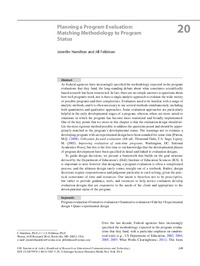Planning a Program EvaluationMatching Methodology to Program Status
Jennifer Hamilton, Jill Feldman
Zu finden in: Handbook of Research on Educational Communications and Technology (Seite 249 bis 256), 2014
|
 |
 Diese Seite wurde seit 9 Jahren inhaltlich nicht mehr aktualisiert.
Unter Umständen ist sie nicht mehr aktuell.
Diese Seite wurde seit 9 Jahren inhaltlich nicht mehr aktualisiert.
Unter Umständen ist sie nicht mehr aktuell.
 Zusammenfassungen
Zusammenfassungen
 As Federal agencies have increasingly specified the methodology expected in the program evaluations that they fund, the long-standing debate about what constitutes scientifically based research has been resurrected. In fact, there are no simple answers to questions about how well programs work, nor is there a single analytic approach to evaluate the wide variety of possible programs and their complexities. Evaluators need to be familiar with a range of analytic methods, and it is often necessary to use several methods simultaneously, including both quantitative and qualitative approaches. Some evaluation approaches are particularly helpful in the early developmental stages of a program, whereas others are more suited to situations in which the program has become more routinized and broadly implemented. One of the key points that we stress in this chapter is that the evaluation design should utilize the most rigorous method possible to address the questions posed and should be appropriately matched to the program´s developmental status. The warnings not to evaluate a developing program with an experimental design have been sounded for some time [Patton, M.Q. (2008). Utilization focused evaluation (4th ed). Thousand Oaks, CA: Sage; Lipsey, M. (2005). Improving evaluation of anticrime programs. Washington, DC: National Academies Press], but this is the first time to our knowledge that the developmental phases of program development have been specified in detail and linked to evaluation designs.
As Federal agencies have increasingly specified the methodology expected in the program evaluations that they fund, the long-standing debate about what constitutes scientifically based research has been resurrected. In fact, there are no simple answers to questions about how well programs work, nor is there a single analytic approach to evaluate the wide variety of possible programs and their complexities. Evaluators need to be familiar with a range of analytic methods, and it is often necessary to use several methods simultaneously, including both quantitative and qualitative approaches. Some evaluation approaches are particularly helpful in the early developmental stages of a program, whereas others are more suited to situations in which the program has become more routinized and broadly implemented. One of the key points that we stress in this chapter is that the evaluation design should utilize the most rigorous method possible to address the questions posed and should be appropriately matched to the program´s developmental status. The warnings not to evaluate a developing program with an experimental design have been sounded for some time [Patton, M.Q. (2008). Utilization focused evaluation (4th ed). Thousand Oaks, CA: Sage; Lipsey, M. (2005). Improving evaluation of anticrime programs. Washington, DC: National Academies Press], but this is the first time to our knowledge that the developmental phases of program development have been specified in detail and linked to evaluation designs.To guide design decisions, we present a framework that builds on the goal structure devised by the Department of Education´s (DoE) Institute of Education Sciences (IES). It is important to note however that designing a program evaluation is often a complicated process, and the ultimate design rarely comes straight out of a textbook. Rather, design decisions require responsiveness and judgment particular to each setting, given the practical constraints of time and resources. Our intent is therefore not to be prescriptive, but rather to provide guidance, tools, and resources to help novice evaluators develop evaluation designs that are responsive to the needs of the client and appropriate to the developmental status of the program.
 Dieses Kapitel erwähnt ...
Dieses Kapitel erwähnt ...
 Begriffe KB IB clear | Evaluationevaluation |
 Zitationsgraph (Beta-Test mit vis.js)
Zitationsgraph (Beta-Test mit vis.js)
 1 Erwähnungen
1 Erwähnungen 
 Anderswo finden
Anderswo finden
 Volltext dieses Dokuments
Volltext dieses Dokuments
 |  Planning a Program Evaluation: Matching Methodology to Program Status: Artikel als Volltext bei Springerlink ( Planning a Program Evaluation: Matching Methodology to Program Status: Artikel als Volltext bei Springerlink ( : :  , 238 kByte; , 238 kByte;  : :  2020-11-28) 2020-11-28) |
 Anderswo suchen
Anderswo suchen 
 Beat und dieses Kapitel
Beat und dieses Kapitel
Beat hat Dieses Kapitel während seiner Zeit am Institut für Medien und Schule (IMS) ins Biblionetz aufgenommen. Beat besitzt kein physisches, aber ein digitales Exemplar. Eine digitale Version ist auf dem Internet verfügbar (s.o.). Aufgrund der wenigen Einträge im Biblionetz scheint er es nicht wirklich gelesen zu haben. Es gibt bisher auch nur wenige Objekte im Biblionetz, die dieses Werk zitieren.










 Biblionetz-History
Biblionetz-History